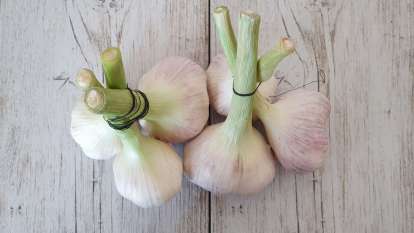Garlic
Garlic and its benefits on the body
Garlic, one of the most popular spices in the kitchen around the world, brings many benefits to our health, being a powerful antibiotic, but more than that, it regulates cholesterol levels. Garlic is a plant with origins in Central Asia, being one of the most popular spices. Its medical benefits are known internationally, both as a treatment for wounds and infections.
In general, garlic is an edible plant, often used as food and spice, a product rich in vitamins and minerals. In addition, administered in combination with honey, it is beneficial in preventing or ameliorating cardiovascular disease, pneumonia and digestive disorders. And let’s not forget that garlic has an important anthelmintic effect.
Nutritional values of garlic (100 g):
- Calories: 149 kcal;
- Carbohydrates: 33.06 g;
- Fiber: 2.1 g;
- Protein: 6.36 g;
- A varied complex of vitamins (A, IU, B1, E. B2, B3, B5, B6, K, C, B9 – folic acid);
- Minerals (calcium 181 mg, magnesium, selenium, potassium, sodium etc.);
- Mono saturated fatty acids (0.011 g);
- Unsaturated fatty acids (0.249 g);
- Saturated fatty acids (0.089 g);
- Amino acids;
- Phytonutrients.
Benefits of garlic
Garlic is one of the most used and researched spices on the market so that its benefits on the cardiovascular system, on infections, on the respiratory system, on blood sugar levels etc. can be fully know.
- garlic fights infections of the throat and tonsillitis;
- garlic has benefits on blood pressure – it is reduced by the fact that the blood vessels are dilated, but the circulation is open and relaxed;
- fresh garlic juice inhibits the development of fungi and if used for a longer period of time, it prevents skin and fungal infections of the skin;
- the beneficial effects on cholesterol are no longer a secret, to which we add the benefits on liver function;
- fresh garlic fights bacteria, worm infections and can kill bacteria such as Salmonella or E.coli;
- can treat herpes and fungus on the feet, but also warts;
- garlic juice soothes itching and rashes caused by insect bites;
- it increases insulin levels, being ideal for diabetics.
Contraindications and side effects
Garlic is a healthy food with countless scientifically proven benefits for most people when taken orally, even if it causes bad breath for some people. But, as with any food, there are side effects. Some of the side effects of garlic are:
- burning in the mouth and stomach;
- gas;
- odor of perspirations;
- nausea;
- vomiting;
- diarrhea.
If eaten raw, the side effects may be more pronounced. Different reactions can also occur, depending on each person’s body. Some research indicates the asthma has been reported in people who consume large amounts of garlic.
There are also some cases in which garlic should not be administered. For example, those who suffer from bleeding disorders or those who take anticoagulant drugs, but also those who are about to undergo surgery should avoid consuming this spice in medicinal doses.
People suffering from irritable bowel syndrome (IBS) should avoid garlic because of the compounds in its composition.
How to consume garlic
In general, garlic is not consumed in large quantities, but it contains enough nutrients so that it can be added without problems to a healthy diet. This spice can be eaten raw, due to the high concentration of allicin found in its composition. Even if some people avoid it because of the strong smell, a large number.
Garlic can be eaten in its natural form, on grilled meat, in stews and in many other dishes. Consuming garlic in food is a great way to benefit from the vitamins and nutrients in this product. Pickled. Yes, you read that right. Garlic cloves are preserved and consumed in this way, often in combination with other herbs.
Cataplasm. Although the smell may seem an important impediment, the use of a preparation of crushed garlic cloves is very effective in treating various skin conditions, such as acne and warts.
How garlic works
Most of the medicinal properties of garlic are due to the sulfuric compounds allicin and ajoena. The first of these is the most beneficial to the body and offers that unmistakable aroma and acts antibacterial and antifungal. Ajoena has an effect on blood vessels and reduces the level of lipids in the body. In other words, garlic has countless benefits on the body, regardless of the form in which it is administered, but in moderate amounts.
Garlic is a spice that should never be missing from our kitchen. Whether raw or pre-cleaned, garlic is easy to find in most grocery stores or local markets. Garlic’s reputation for being good at everything is certainly not out of nowhere. The benefits of garlic on the body have been known since ancient Egypt and can be used both for cooking and for treating health problems, high blood pressure, high cholesterol, colds and many other infections.




Comments